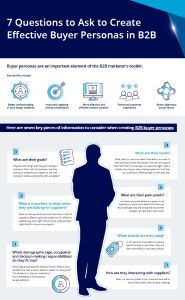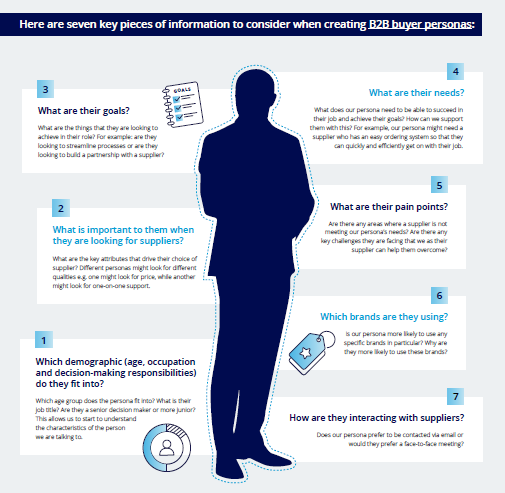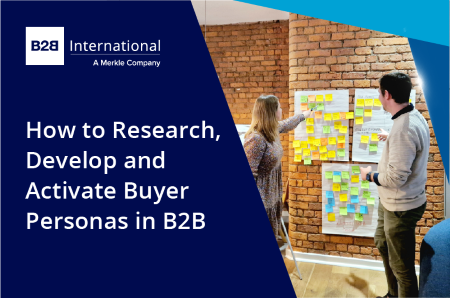
Buyer personas are becoming an increasingly important element of the business-to-business marketer’s toolkit. This article outlines seven key points to bear in mind when researching, developing and activating B2B buyer personas in your organization.
What Are B2B Buyer Personas?
Marketing and advertising is expensive and can be ineffective. Companies can end up marketing and advertising to people who are not relevant or who have no interest in their products or services. To avoid wasting large amounts of money, we need to focus on somebody when we communicate to our target audience rather than just anybody. The “somebody” referred to here, really is somebody – a person or a character which strongly represents our target audience.
We call these characters personas and we need to build a picture of them before we start marketing to them. A buyer persona is a character with a personality and key characteristics which help you to understand who you are talking to, designing a product for and doing business with. B2B buyer persona creation nearly always focuses on the key buyer or main decision maker of a product or service.
5 Reasons to Use Buyer Personas in B2B Markets
Creating different B2B buyer personas can have a number of benefits:
-
Better understanding of your target audience
Buyer personas provide a comprehensive view of your target audience. They go beyond demographics and job titles to capture the real people behind the decision-making process. You’ll learn about their goals, challenges, frustrations, and how they perceive your product or service. This understanding of your target audience is critical to designing a marketing strategy that resonates with them.
-
Improved targeting and personalization
Using buyer personas, you can develop targeted and personalized marketing campaigns that resonate with your ideal customers. By understanding their pain points and challenges, you can tailor your messaging and content to address their specific needs. This personalization increases the chances of attracting their attention and building a relationship with them.
-
More effective and efficient content creation
Creating content that appeals to everyone is unlikely to resonate with anyone. With buyer personas, you can create content that speaks directly to your ideal customers’ needs and interests. This content is more likely to be read, shared, and engaged with, leading to a higher ROI on your content marketing efforts. Moreover, it can save you time and resources by focusing on the content that’s most likely to be effective.
-
Enhanced customer experience
Buyer personas can also guide the customer experience by identifying pain points and touchpoints throughout the buyer’s journey. By understanding how your ideal customers make decisions and interact with your brand, you can develop a frictionless and engaging customer experience. You can tailor your messaging and communications to their preferences and interests, helping them feel seen, heard, and valued. This enhances their experience and increases their likelihood of becoming loyal customers.
-
Better alignment across teams
Finally, buyer personas can help align your marketing, sales, and product teams around a shared understanding of your target audience. When everyone is on the same page, they can more effectively work together to design and execute customer-centric strategies. Buyer personas provide the framework for decision-making, ensuring that every department puts the customer’s needs at the forefront.
A sales and marketing strategy focused towards detailed, research-led personas also makes it far easier to satisfy the Four W’s:
- Who? Targets the right groups of customers/prospects
- What? Uses the right messaging – a proposition which is relevant to the target, as well as being unique and defensible
- Where? Reaches them through the right sources and channels, in the right formats
- When? Reaches them at the right time, at the right point in their buying journey
7 Questions to Ask to Create Effective Buyer Personas in B2B
Below are seven key pieces of information to consider when creating B2B buyer personas or conducting buyer persona research:
-
Demographics such as age, occupation and decision making responsibilities
Which age group does the persona fit into? What is their job title? Are they a senior decision maker or more junior? This allows us to start to understand the characteristics of the person we are talking to.
-
What is important to them when they are looking for suppliers?
What are the key attributes that drive their choice of supplier? Different personas might look for different qualities e.g. one might look for price, while another might look for one-on-one support.
-
What are their goals?
What are the things that they are looking to achieve in their role? For example: are they looking to streamline processes or are they looking to build a partnership with a supplier?
-
What are their needs?
What does our persona need to be able to succeed in their job and achieve their goals? How can we support them with this? For example, our persona might need a supplier who has an easy ordering system so that they can quickly and efficiently get on with their job.
-
What are their pain points?
Are there any areas where a supplier is not meeting our persona’s needs? Are there any key challenges they are facing that we as their supplier can help them overcome?
-
Which brands are they using?
Is our persona more likely to use any specific brands in particular? Why are they more likely to use these brands?
-
How are they interacting with suppliers?
Does our persona prefer to be contacted via email or would they prefer a face-to-face meeting?
B2B Buyer Persona Examples
The point of buyer persona development is to bring your customers to life and you can even take persona creation further! When one of our clients has a discussion about their customers they bring in a large cardboard cut-out of their B2B customer persona, for example, Technical Tony. Although this may seem extreme, it has a serious point. It keeps the team focused on their customers and the specific audience (somebody) they are talking about.
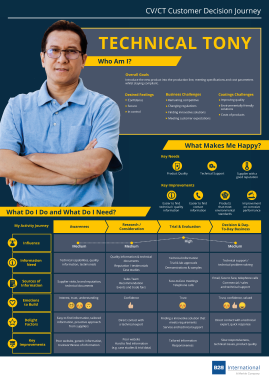
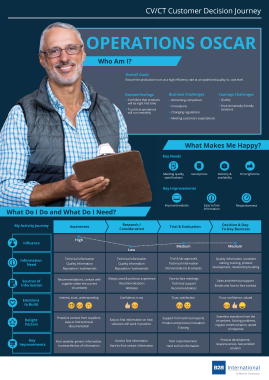
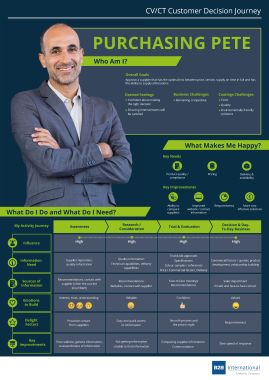
7 Best Practices for Developing and Embedding Buyer Personas in B2B
1. Segmentation is effective in supporting persona creation, but is not a necessary condition
For a time, segmentation and buyer persona development were considered to be one and the same. Maybe this all comes down to semantics. Are personas simply segments in disguise? Is this merely a marketing buzzword which will be replaced in due course with something else?
Certainly, segmentation and buyer personas are connected in terms of the objective: to establish distinct and targetable groups with an organization’s customer base and/or market. The distinction however, is in presentation. A segmentation delivers a typology of the customer or market universe: which “types” of customers/prospects exist? A persona is – wait for it – personified. Rather than “Segment A”, we have Stephen. Rather than the “Performance Seeker” segment, we have Emma the chemicals buyer, who happens to prefer to procure top-end services for a premium price.
It may seem petty to make such a distinction. Ultimately though, it comes down to basic human psychology. One of the challenges organizations face with segmentations is that it can be difficult for teams to understand segments in ways that stimulate ideas and actions. As human beings, it is much easier for us to articulate a response to somebody than something. Buyer personas are therefore a practical solution to a major pitfall of segmentation, adding a personality to an otherwise faceless segment.
The buyer persona development journey needn’t include segmentation, at least not in its traditional form. Typically, segments are created as a result of a dedicated market study, be it quantitative (enabling statistical segmentation) or qualitative (enabling directional segmentation). Many organizations have been slow in developing buyer personas in the absence of a segmentation. It is important in these circumstances not to let perfection be the enemy of good. A solid segmentation effort provides a strong foundation for persona creation, but it is not a condition of entry.
2. Insights to inform buyer persona development don’t all need to be researched… but it does help!
By the same token, organizations should not feel handcuffed by a lack of primary data from the customers or markets of focus. Certainly, research helps to inform personas. It is not the “be-all and end-all.” Before putting pen to paper on your personas, consolidate any insights from the following sources and establish any gaps in your knowledge:
- Primary market research (surveys, focus groups, speaking to customers)
- Secondary market research (desk research, articles, reports)
- Internally-held data (on markets, customers, sales figures)
- Anecdotal insights / instinct (drawn from experience)
Be careful not to underestimate the value of experience here, especially if there is a dearth of objective, independently-gathered insights or data. As with segmentation, the question here should not be whether or not personas can be developed without data; it should be “how valuable could our personas be using inputs from a range of sources?” Ultimately, organizations should work with what they have and what they can feasibly obtain. Do not fall foul of the Nirvana Fallacy: the choice between an imperfect achievable outcome and a perfect but unachievable outcome is a simple one.

3. Conduct a brainstorming session to transition from segment/group to persona
Whether or not your personas are guided by insights and/or a segmentation effort, it is important not to “jump the gun” during the buyer persona development process. Stephen or Emma (or whatever you choose to name your buyer personas) cannot be borne from nothing. It is much better to think first of groups and to describe them as such, before putting a face and a name to that group.
This may seem mundane, but it will lead to more relevant personas, with specific characteristics linked to your target audience. Before asking “what is Stephen’s inside leg measurement?” ask “what does Customer Group 1 look like?” in terms of structure, size, industry, individual role, need, behaviors, etc. In short, don’t drown in your creative juices before you’ve had a chance to get the boring stuff out of the way.
Once your organization has a description of customer/market groups in place (however basic or sophisticated), it is time to get all relevant stakeholders in a room to create the persona themselves. Any insights should be made available and descriptions of the segment/groups should be present and widely understood. Aim to create most or all of your personas in this creative, “brainstorming” session, rather than getting bogged down establishing a detailed implementation plan, which may risk distracting and derailing what should be a hyper-creative exercise.
4. Don’t worry about generalizing – a persona is a “best fit” characterization
One of the major pushbacks we experience when helping clients during buyer persona development is the view that each persona must perfectly describe an individual customer (or worse, perfectly describe every customer within the chosen segment). What’s more: organizations often become skeptical of buyer personas because they may seem exaggerated or caricatured in some way.
Our response to that is that there is a difference between a persona and a person – an actual, real-life person. If we apply no distinction between the two, then an organization with 1,000 customers must have 1,000 personas. In a perfect world, we would speak to and serve each customer differently. We would have a unique understanding of each customer that can be applied to sales and marketing activity. Unfortunately, we live in a world with limitations.
Therefore, organizations work within their boundaries rather than not working at all. Think of each persona as a “best fit” characterization. If Emma is 40 years old and works for a large refining company, and not every customer within the group is 40 years old and works for a large refining company, that’s ok.
5. The clue is in the name: each buyer persona should be described in terms of a person
Here’s where the creativity can go into overdrive. The most effective buyer personas are not those which simply describe Emma, her age and the company she works for. Your persona needs a personality. He/she needs physical, social and emotional characteristics, as well as backgrounds, goals and values.
It may be difficult to make the leap from “what products shall we sell to Segment 1?” to “what is Emma’s favorite book?” It is probably best to work towards this in stages in the brainstorming session. For example:
- Exercise 1: describe a day in the life of the persona (strong, tangible link with the business; little creativity required)
- Exercise 2: create a LinkedIn profile for the persona (focus on professional behaviors and needs; direct link with the business; more creativity required)
- Exercise 3: create a Facebook profile for the persona (focus on personal behaviors and needs; indirect link with the business; most creativity required)
One small caveat here: in attempting to be creative and provide Emma/Stephen with a personality, you may find yourselves moving so far away from the business goal that it becomes difficult to drive action based on your understanding of the persona. Best practice here is to force a justification of a characteristic or descriptor before it is added to the persona “profile”. If knowing that Emma likes science fiction novels can tell us (or remind us about) something of her purchasing needs or service requirements (e.g. she craves innovation and is willing to think outside the box when considering products), then it should be included. If it is entirely superfluous and has the potential to cause a misunderstanding rather than a better understanding of the customer, it should be avoided.
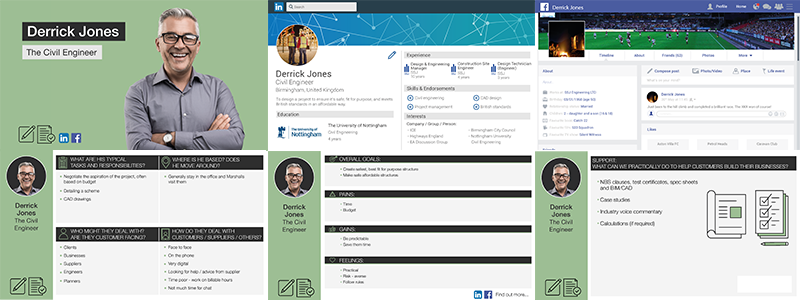
6. Implementing the persona is impossible without visualization and visibility
Once your “family” of personas are in place, the journey does not end. On the contrary, this is merely the beginning. It is likely at this point that each persona is familiar only to a small group of people within the organization, and only exists in the form of scribbled notes and (possibly) the odd sketch. The buyer personas must now be brought to life and introduced to the rest of the organization.
Variety is the spice of life and organizations should endeavor to visualize their personas using a range of media. Examples adopted by others include (ordered from basic to complex):
-
Profile posters with photographs of each persona, accompanied with key characteristics and a description of key needs, products, sales/marketing messages which may resonate strongly. These posters should be distributed to employees and prominently displayed in offices/locations. You may also wish to create cardboard cut-outs of the personas, which then take up residence in meeting rooms or other office space. During internal discussions, staff should look over their shoulders and ask “What would Steve say?”
-
LinkedIn and/or Facebook profiles, designed to look realistic and sometimes actually created (enabling “connections” or “friendships” with people within the organization).
-
Email messages from personas to introduce them to the organization and to enable a direct interaction with them. Personal contact with personas triggers interest and deepens understanding of different customer segments.
-
Online portals, offering an interactive platform to explore the different aspects of a persona’s life (i.e. having a look at the persona’s work desk, his/her social media profiles) and to offer extensive information in an easily digestible format.
-
Face-to-face interactions with actors playing buyer personas at internal events brings personas to life in a literal sense, initiating further conversation and making it a memorable experience for each employee.
7. Encourage conversations around the personas and keep them up-to-date
The ways in which a persona can be visualized and embedded within an organization are endless. Try to think of other ways in which you could encourage a conversation about your personas and create a long-lasting impression among your colleagues. The ultimate goal here is to develop a company culture of customer centricity, helping to keep the customer (and different customer types) at the forefront of all strategic decisions and in everyday operations.
Markets, competitors and customer requirements are constantly evolving. Therefore, it is essential that you revisit buyer personas periodically. This process should be done twofold:
1. Continuous buyer persona development
The best way to keep your personas relevant is to spark on-going anecdotal conversations discussing how the persona could have evolved over the past few months (i.e. How would Steve be feeling about the new industry regulations affecting companies like his?) Ideally these conversations should happen frequently. If you’re finding that this isn’t naturally the case, make an effort to get together to discuss every 3 months.
2. Formal persona audits
Every 3-4 years, you should revisit the whole buyer persona development process, refreshing any insights you may have, creating personas from scratch and developing a revised strategy on embedding personas in your organization. It is not recommended to carry out the process more frequently than every 3 years, as you can easily lose momentum and fail to take full advantage of the benefits of your existing personas.
Summary
When creating B2B buyer personas, you should always remember that there will almost certainly be a number of personas involved in the decision making process. Business-to-business buying decisions are not usually made by just one person. This means you may need to develop a number of personas and understand the interactions between them when it comes to decision making. You will also need to make sure that your marketing resonates with each of the personas.
When marketing to the different personas, you will have the same value proposition, but you may want to use different words and images that ensure it resonates with each of the different personas. For example, a persona working in a procurement role will identify with different messaging than a persona working in a more technical role.
Readers of this article also viewed:


